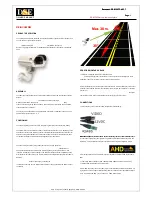
101
ķ
11.5 Preflash function for red-eye
reduction
The red-eye effect occurs when the per-
son being photographed is looking for
more or less straight into the camera, the
ambient lighting is poor, and the flash
unit is mounted close to the camera. The
flash unit then illuminates the interior of
the subject’s eyes through the pupils.
Some camera models have a preflash
function for reducing the red-eye effect.
One or more preflashes induce the
pupils to contract more, thereby redu-
cing the red-eye effect.
On some cameras, the preflash function
supports only the camera’s internal
flash unit or an illuminator incorporated
in the camera body.
The preflash function is set on the
camera (see the camera’s operating
instructions)! Second curtain synchroni-
sation (REAR) is not possible when the
preflash function is used. There is no
setting or display for this mode on the
flash unit.
12 Automatic AF measuring
beam
The automatic AF measuring beam
is
activated in the flash unit by the camera
when the ambient lighting conditions
become inadequate for automatic focu-
sing. A striped pattern is projected onto
the subject which the camera can use to
focus. Depending on the camera’s activa-
ted AF sensor, the AF beam has a range
of approximately 6 m to 9 m (with a stan-
dard 1.7/50 mm lens). Parallax error
between lens and AF measuring beam
limits the close-up range with the AF
measuring beam to approximately 0.7 m
to 1 m.
To activate the automatic AF measuring
beam
the camera must be set to the
„single AF (S)“ autofocus mode and the
flash unit must indicate flash readiness.
Some camera models support only the
camera’s internal AF measuring beam.
In this case, the automatic AF measu-
ring beam of the flash unit is not activa-
ted (as in the case of compact cameras;
see the camera’s operating instruc-
tions).
☞
☞
Содержание MECABLITZ 44 AF-1
Страница 28: ...28 Ķ Technische Änderungen und Irrtümer vorbehalten ...
Страница 161: ...161 į ...
Страница 162: ...162 ...
Страница 163: ...163 ...
Страница 164: ...164 ...
















































